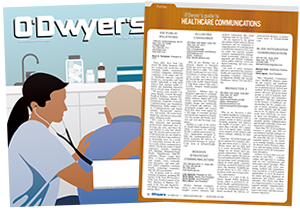 Sharon M. Reis |
|
|
I cite my family’s case to demonstrate that patient engagement is essential yet extremely complicated, and while healthcare in our country is often very good, clinicians and the system are far from perfect. For patients, checking off a to-do list is just not enough to effectively and safely manage complex or chronic medical conditions or to improve overall health.
Understanding complicated medical conditions and navigating the system are seriously challenging. As our healthcare system moves to value-based care, reimbursing for quality over quantity and demanding better care at a lower cost, there’s never been more on the line. So, how can communications professionals play a role in helping patients and families get the information they need to make informed and confident decisions about their health and healthcare?
A priority for hospitals, health systems
Patient engagement is a top concern for hospitals and health systems. “Almost half of the healthcare executives in the Advisory Board Company’s annual member survey said they are extremely interested in addressing consumer needs and expectations in the healthcare settings,” said Pete Simpkinson, Senior Director of Strategic Marketing of The Advisory Board Company. “Another 45 percent of respondents said they are strongly focused on identifying patient engagement strategies. Both of these concerns ranked among the top five.”
More knowledge and tools
A May article in the New England Journal of Medicine identified three primary components of patient engagement: becoming motivated to learn and take ownership of making choices about their care, adhering to care plans, and taking a more active role in improving their health.
That NEJM article also presented findings from a survey of clinicians, clinical leaders and healthcare executives that showed improved patient engagement usually leads to better health outcomes, but that getting patients actively involved requires more knowledge and tools.
“We all have a role to play in making sure consumers and families are engaged in their mental and physical healthcare,” said Stephanie Coggin, Vice President of Communications and marketing at the American Foundation for Suicide Prevention. “Through research, we know that reaching out and talking to someone about suicide can save more lives. It’s through communications that we can begin to shift attitudes to better understand that our mental health is just as important as our physical health, and creating tools to engage patients and families in their care will lead to better outcomes and save lives.”
The role of communications
Communications teams have a key role in making sure that patients know that engagement is a top priority, and in providing resources to help make it happen.
The Reis Group recently surveyed PR professionals from 15 associations and hospitals/health systems to better understand whether and how they are undertaking patient engagement efforts. Our survey found that most of them — 11 of 15 — are working on or planning to take action.
Survey participants reported the top five strategies for engaging patients and their families include: participating in shared decision-making, having conversations with clinicians, creating care goals, learning more about your medical condition and seeking care in the community.
“High-quality medical care is built on trust between doctors and patients, and an open exchange of information among specialties so that patients can make the best choices for their care,” said Elise Castelli, Senior Manager for Communications and PR for the Society of Interventional Radiology. “SIR believes that engaging patients is critical to ensuring quality care. Our new website will include a patient center that will provide easy, accessible descriptions of interventional radiology treatments, so patients have the information they need to feel confident in their care decisions.”
Creating patient engagement initiatives
Creating effective communications efforts to engage patients can be fraught with pitfalls. Below are five key factors we have identified from our market research with patient and family advocates, health professionals, hospital decision-makers, and foundation leaders to effectively encourage and enable patient engagement in healthcare settings.
We are in this together. No one appreciates or benefits from finger-pointing and blaming. A critical element to this discussion is not to tell the patient how to be a better patient and not to tell clinicians they aren’t doing a good job.
One size does not fit all. More and more, the feedback we hear is to get to the heart of the matter as quickly as possible. This means messages tailored to your various audiences. Clinicians want to see the data. On the other hand, patients and families want to know what it means for their specific care and their loved ones. Healthcare leaders or policymakers want to know how this new program or activity will increase or decrease costs.
Watch your word choices. Words carry different meaning for each of the key players in healthcare. For example, we have learned that patient advocates can respond negatively to the word “empower.” It can be viewed as condescending because it is something that you offer and provide to someone; whereas “engagement” is something that people do for themselves.
Be inclusive. Include families whenever talking about patients. Also, consider the impact of hospital and healthcare decisions beyond clinical care on patients and families and include this core constituency in your communications plans whenever possible.
Be clear. Explain complex terms with examples tailored for the intended audience. Whenever possible, write at an eighth grade reading level or below to ensure materials can be well-understood across patient populations.
For healthcare communications, there’s always been a need to reach patients and clinicians with messages and materials. Now, our work to encourage and influence conversations and to provide information to promote shared decision-making will be more vital than ever before to improve care, costs, and outcomes.
* * *
Sharon M. Reis is Principal of The Reis Group and Co-Founder of GYMR Public Relations.



 Lo Isidro, senior director at Real Chemistry with more than a decade of strategic communications and PA experience, has joined Narrative Strategies.
Lo Isidro, senior director at Real Chemistry with more than a decade of strategic communications and PA experience, has joined Narrative Strategies. Nelson Fernandez, former North American chair of APCO Worldwide and managing director of Burson-Marsteller, has joined Volunteers in Medicine Berkshires as director of communications and PA.
Nelson Fernandez, former North American chair of APCO Worldwide and managing director of Burson-Marsteller, has joined Volunteers in Medicine Berkshires as director of communications and PA. Lilit Bargar, who was most recently an EVP in the healthcare practice at Weber Shandwick, comes on board at GCI Health as EVP, corporate practice lead.
Lilit Bargar, who was most recently an EVP in the healthcare practice at Weber Shandwick, comes on board at GCI Health as EVP, corporate practice lead.
 Five ways that successful thought leaders are made.
Five ways that successful thought leaders are made.


 Have a comment? Send it to
Have a comment? Send it to 
No comments have been submitted for this story yet.